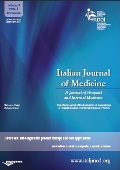Reviews
24 December 2013
Vol. 7 No. s8 (2013): The new oral anticoagulants in the Internal Medicine clinical practice
Monitoring strategies for patients treated with the new oral anticoagulants and the need for laboratory evaluation of hemostasis

Publisher's note
All claims expressed in this article are solely those of the authors and do not necessarily represent those of their affiliated organizations, or those of the publisher, the editors and the reviewers. Any product that may be evaluated in this article or claim that may be made by its manufacturer is not guaranteed or endorsed by the publisher.
All claims expressed in this article are solely those of the authors and do not necessarily represent those of their affiliated organizations, or those of the publisher, the editors and the reviewers. Any product that may be evaluated in this article or claim that may be made by its manufacturer is not guaranteed or endorsed by the publisher.
925
Views
900
Downloads






